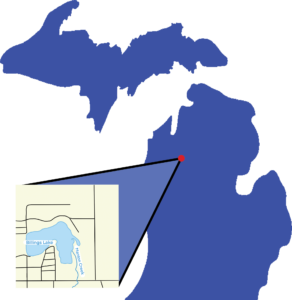
Over the years, levels of E. coli have been a consistent problem for Billings Lake in Manton of Wexford county, causing multiple beach closures every summer.
After developments made in 2020 under the guidance of assistant professor of biological sciences Sky Pike, Ferris student researchers hope to “pin down” the source of E. coli within the next year.
“We’re hoping we’ll find the cause. We go step by step to figure out what’s going on. We had a major step last year when we figured out that all the E. coli is not originating in the lake,” Pike said. “It’s actually originating upstream somewhere in Manton Creek and it’s originating after we get a rain event of greater than one inch.”
Because of this discovery, researchers will focus their data collection on Manton Creek rather than Billings Lake once the project starts back up this summer.
Students from Ferris, as well as several other Michigan universities, were invited to join this project in 2016 by Michigan’s Department of Environment, Great Lakes and Energy and the District Health Department No. 10.
EGLE, DHD 10 and the Wexford County Drain Commission have provided the team of researchers with equipment for a quantitative polymerase chain reaction testing method.
“We were brought in because District Health Department No. 10 didn’t have the expertise to be able to know how to use the [qPCR] equipment,” Pike said.
Biotechnology senior Ethan Tippett has participated in this qPCR testing method and described what an average day of research looks like.
The team collects weekly water samples from five to 10 sites, depending on conditions. From there, the samples are kept on ice and brought to the lab for DNA extraction.
“We would filter the water to concentrate all of the bacteria, including E. coli, that we’re looking for. And then using filters we would extract the DNA from each of the samples,” Tippett said. “After extracting the DNA, we would run qPCR, quantitative polymerase chain reaction, to determine the amount of E. coli.”
Recent graduate of biotechnology and forensic biology Kassidy Vredeveld has worked with qPCR equipment on this project as well as in COVID research.
“Basically, qPCR is just measuring the amount of the DNA in a sample based on its amplification,” Vredeveld said.
With this method, researchers are able to split E. Coli DNA into two individual strands. From there, the sample is amplified and observed through exponential growth.
This process has prompted Pike to refer to the qPCR machine as a “copy machine for DNA.”
The qPCR testing method is much more efficient than the traditional culture-based method, which takes about 24 hours to yield results.
“Some days we were able to run the entire process within the day and get results either later that day or the next morning, so that’s pretty different,” Tippett said.
Finding the source of this contamination involves microbial source tracking. While there is no difference between human E. coli and animal E. coli in terms of risk, the source will determine the solution.
“Let’s say it is human, but what could be the causes of that?” Pike said. “Well, maybe there’s a leak in the sewer system. Or maybe there’s an old septic system somewhere that is not used, but it still has E coli growing in it and when you get a big rain it washes out. So that’s a different situation than, for instance, if you have high levels of E Coli from deer, or from birds, or from cows.”
While microbial source tracking is the future of this project, one alternative, but ultimately unsatisfactory, method involved canine researchers.
“Two years ago, we actually had two students that went out in a canoe and got samples for dogs to sniff for human scent. They paddled back and actually got stuck in the mud and weeds on the far end of the lake for about an hour,” Pike said.
Tippet feels proud of the work he has done on this project and would like to thank Pike for the opportunity.
“We’re trying to make it safe for people to swim and take their dogs and take their kids out to the beach and just enjoy a day in the summer,” Tippett said.
Research for the source of E. coli contamination in Manton Creek is set to resume in June and continue for 14 weeks.
